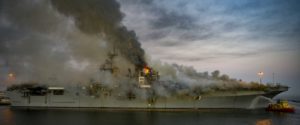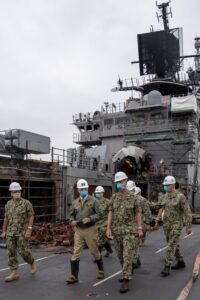A new Government Accountability Office (GAO) report found the Navy does not have a process to consistently share lessons learned to improve behavior and reduce fire risks during ship maintenance.
The April 20 report said while the Navy has a process to collect and analyze lessons learned from fire incidents via several processes, it does not have a process for consistent collecting, analyzing and sharing the lessons across the service.

“As a result, the Navy has lost lessons learned over time—such as steps that a ship can take to improve fire safety. Organizations that GAO interviewed collected lessons learned from fires; however, they had not consistently used the approved Navywide system to store and share them. Establishing a process for the consistent collection, analysis, and sharing of fire-related lessons learned would assist the Navy to improve behavior and reduce the risk of ships repeating costly mistakes,” the report said.
In the wake of the fire that catastrophically damaged the USS Bonhomme Richard (LHD-6) in 2020, the Navy started improving collecting data related to fires aboard ships during maintenance in the service’s safety database (Defense Daily, April 15, 2021).
However, GAO noted “no organization is analyzing the broad effects of fires on the Navy’s operations and strategic resources. Without conducting such analyses, the Navy will not have a complete picture of the magnitude of risks associated with ship fires.”
GAO noted after a major 2012 fire damaging the USS Miami submarine that caused the department to decide to decommission it rather than repair, “the Navy realized that it could not afford another setback from a fire of this magnitude. Navy officials recognized a need to raise the Navy’s standards and capabilities to improve fire safety, and to develop cost-effective solutions to improve fire prevention and detection, immediate response, and extended response for ships undergoing maintenance.”
However, the report argued while the Navy increased standards and capabilities to improve fire safety, it still experienced nine other major fires aboard ships undergoing maintenance leading to LHD-6.
The Navy told GAO 15 major fire incidents from 2008 to 2020 have cost the Navy $4 billion in damages, in addition to injuries. The damage to LHD-6 alone resulted in $3 billion in costs and the decision to decommission an important amphibious assault ship that had years left in its expected service life, leading to adjustments like shortening the maintenance period of the USS Makin Island (LHD-6).
After the Bonhomme Richard fire, the Navy conducted a comprehensive review of 15 major fires from 2008 to 2020, finding 12 significant issues and leading to 56 corrective actions and recommendations.
The report underscored that while the Joint Lessons Learned Information System is the Navy’s system of record for documenting and sharing lessons learned, one of its limiting factors is it contains limited information that Navy organizations have learned from fire incidents on ships undergoing maintenance.
Officials from program director Navy Warfare Development Command told GAO they have “limited access to fire-related lessons learned from shipyards because the information may contain personnel identifying information or privileged safety incident information.”

While the command is allowed to redact personal identifying information from safety reports, the time that takes “delays the availability of useful lessons learned.”
GAO also found organizations have not consistently used the Navy’s system of record for lessons learned to collect and share fire-related lessons learned and best practices.
“The U.S. Fleet Forces Command officials told us that they maintain the fleet’s lessons learned in the Joint Lessons Learned Information System, but U.S. Pacific Fleet officials stated that they have not yet required their type commanders to maintain the fleet’s lessons learned in the Joint Lessons Learned Information System.”
The report underscored Navy organizations also inconsistently use processes to collect, maintain and share fire safety-related and damage control lessons. The range of ways they share this information includes using after-action reports, emails, using a knowledge-sharing network, and biweekly meetings with the fire safety council.
Other GAO conclusions include reduced personnel during maintenance have contributed to fire risks and that the service has not assessed the effectiveness of its fire safety training programs.
The report recommended the Secretary of the Navy and Office of the Chief of Naval Operations ensure the service issues guidance to require a process that will allow for consistent collection, analysis and sharing of fire safety-related learning; ensure a single organization is responsible for using existing fire incident data to analyze broad effects fire incidents on ships undergoing maintenance have on Navy operations to inform risk response; and establish service-wide goals and performance measures for fire safety training activities as well as a process to monitor and report progress on the goals.
The Navy concurred on all recommendations and agreed to implement the changes.